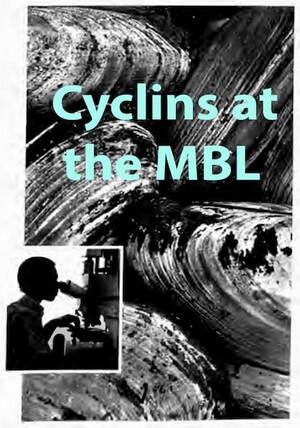Cyclins are the molecules that allow for the progression of the cell cycle. The cell cycle is the process by which cells replicate their DNA and divide. Eukaryotes have two different kinds of cells, somatic cells and sex cells. Somatic cells make up most of the cells of the body. There are four phases of the cell cycle of somatic cells: Gap 1 (G1), where cells increase in size; Synthesis (S), where the cell’s DNA is replicated; Gap 2 (G2), where the cell continues to grow; and Mitosis (M), where the cell divides into two identical cells with the same genetic information. Cells can also enter a fifth phase of the cell cycle known as the resting phase (G0), which occurs during Gap 1 phase. The resting phase can play a variety of roles in an organism and is particularly important in the study of sea urchin (Arbacia punctulata) eggs that Tim Hunt used for his research with cyclins.
In order to ensure that the cell cycle in somatic cells produces the correct products, the cell cycle has several checkpoints. At those checkpoints, different proteins carry out a number of biochemical reactions to regulate the process. This is where cyclin comes in. Many of the proteins that regulate the cell cycle are cyclin dependent kinases: enzymes activated by the presence of a cyclin.
What are Cyclins?
- Branden, C. I. (1999). Introduction to Protein Structure. New York: Garland Science. - https://books.google.com/books?id=eUYWBAAAQBAJ&pg=PA107&lpg=PA107&dq=domain+structure+of+cyclins&source=bl&ots=Pz5XNBd3kZ&sig=n2O3Cw0Vr8GmvuV0y-KF6i0PfYw&hl=en&sa=X&ei=BQl3VfOqMu-HsQTY5YOwDQ&ved=0CGIQ6AEwCw#v=onepage&q=domain%20structure%20of%20cyclins&f=false
- Hershko, A. (1999). Mechanisms and regulation of the degradation of cyclin B. Philosophical Transactions of the Royal Society B: Biological Sciences, 354(1389), 1571-1576.
- Nobel Prize, 2001. http://www.nobelprize.org/nobel_prizes/medicine/laureates/2001/hunt-bio.html
Early Work with Cyclins
- Boveri, T. (1902). On multipolar mitosis as a means of analysis of the cell nucleus. Foundations of experimental embryology, 1964, 74-97.
- Franz, S. (2002). http://www.nature.com/celldivision/milestones/full/milestone02.html
- Greaves, S. (2002). http://www.nature.com/celldivision/milestones/full/milestone07.html
- Jackson, P.K. (2008). The Hunt for Cyclin. Cell, 134, 199-202
- MBL History Project. "Joan Ruderman Cyclin Research I." Filmed June 2015. MBL History Project Video, 5:58. Posted June 2015. http://history.archives.mbl.edu/node/16066.
- MBL History Project. "Joan Ruderman Cyclin Research II." Filmed June 2015. MBL History Project Video, 8:55. Posted June 2015. http://history.archives.mbl.edu/content/joan-ruderman-cyclin-research-ii-june-5-2015.
- Mitchell, A. (2002). http://www.nature.com/celldivision/milestones/full/milestone03.html
- Nath, D. (2002). http://www.nature.com/celldivision/milestones/full/milestone06.html
- Patterson, M. (2002). http://www.nature.com/celldivision/milestones/full/milestone05.html
- Rosenthal, E. T., Hunt, T., & Ruderman, J. V. (1980). Selective translation of mRNA controls the pattern of protein synthesis during early development of the surf clam, Spisula solidissima. Cell, 20(2), 487-494.
- Surridge, C. (2002). http://www.nature.com/celldivision/milestones/full/milestone01.html
Tim Hunt and His Discovery of Cyclin
- Evans, T., Rosenthal, E. T., Youngblom, J., Distel, D., & Hunt, T. (1983). Cyclin: a protein specified by maternal mRNA in sea urchin eggs that is destroyed at each cleavage division. Cell, 33(2), 389-396.
- Gerhart, J., Wu, M., & Kirschner, M. (1984). Cell cycle dynamics of an M-phase-specific cytoplasmic factor in Xenopus laevis oocytes and eggs. The Journal of Cell Biology, 98(4), 1247-1255.
- Hunt, T. (2001, December 9). Tim Hunt Nobel Lecture Protein Synthesis, Proteolysis, and Cell Cycle Transitions." Nobelprize.org. Retrieved from: http://www.nobelprize.org/nobel_prizes/medicine/laureates/2001/hunt-lecture.html
- Hunt, T. (2004). The Discovery of Cyclin (I). Cell, S116, S63-S64.
- Jackson, P.K. (2008). The Hunt for Cyclin. Cell, 134, 199-202
- Masui, Yoshio, and Clement L. Markert. "Cytoplasmic control of nuclear behavior during meiotic maturation of frog oocytes." Journal of Experimental Zoology Part A: Ecological Genetics and Physiology 177, no. 2 (1971): 129-145.
- Pulverer, B. (2002). http://www.nature.com/celldivision/milestones/full/milestone12.html
- Swenson, K. I., Farrell, K. M., & Ruderman, J. V. (1986). The clam embryo protein cyclin A induces entry into M phase and the resumption of meiosis in Xenopus oocytes. Cell, 47(6), 861-870.
Cyclins and Genetics
- Ciechanover, A., Finley, D., & Varshavsky, A. (1984). Ubiquitin dependence of selective protein degradation demonstrated in the mammalian cell cycle mutant ts85. Cell, 37(1), 57-66.
- Glotzer, M., Murray, A. W., & Kirschner, M. W. (1991). Cyclin is degraded by the ubiquitin pathway. Nature, 349(6305), 132-138.
- Goldstein, G., Scheid, M., Hammerling, U., Schlesinger, D. H., Niall, H. D., & Boyse, E. A. (1975). Isolation of a polypeptide that has lymphocyte-differentiating properties and is probably represented universally in living cells. Proceedings of the National Academy of Sciences, 72(1), 11-15.
- Gould, K. L. & Nurse, P. (1991). Tyrosine phosphorylation of the fission yeast cdc2+ protein kinase regulates entry into mitosis. Nature 342, 39-45.
- Greenwood, E. (2002). http://www.nature.com/celldivision/milestones/full/milestone09.html
- Hartwell, L. H., Culotti, J., Pringle, J. R., & Reid, B. J. (1974). Genetic control of the cell division cycle in yeast. Science, 183(4120), 46-51.
- Hershko, A. (1991). The ubiquitin pathway for protein degradation. Trends in biochemical sciences, 16, 265-268.
- Hershko, A. (1999). Mechanisms and regulation of the degradation of cyclin B. Philosophical Transactions of the Royal Society B: Biological Sciences, 354(1389), 1571-1576.
- Nature. (2004). A prize for protein degradation. Nature Cell Biology, 6(1011), doi:10.1038/ncb1104-1011.
- Nobel Prize 2001 http://www.nobelprize.org/nobel_prizes/medicine/laureates/2001/
- Nobel Prize 2004 http://www.nobelprize.org/nobel_prizes/chemistry/laureates/2004/ ; http://www.nobelprize.org/nobel_prizes/chemistry/laureates/2004/hershko-bio.html
- Nurse, P. (1975). Genetic control of cell size at cell division in yeast. Nature, 256, 547-551.
- Nurse, P., & Thuriaux, P. (1980). Regulatory genes controlling mitosis in the fission yeast Schizosaccharomyces pombe. Genetics, 96(3), 627-637.
- Patterson, M. (2002). http://www.nature.com/celldivision/milestones/full/milestone05.html
- Russell, P. & Nurse, P. (1986). cdc25+ functions as an inducer in the mitotic control of fission yeast. Cell 45, 145-153.
- Schoenheimer, R. (1942). The Dynamic State of Body Constitutents. Cambridge: Harvard University Press.
- Varshavsky, A. (2006). The early history of the ubiquitin field. Protein science, 15(3), 647-654.

